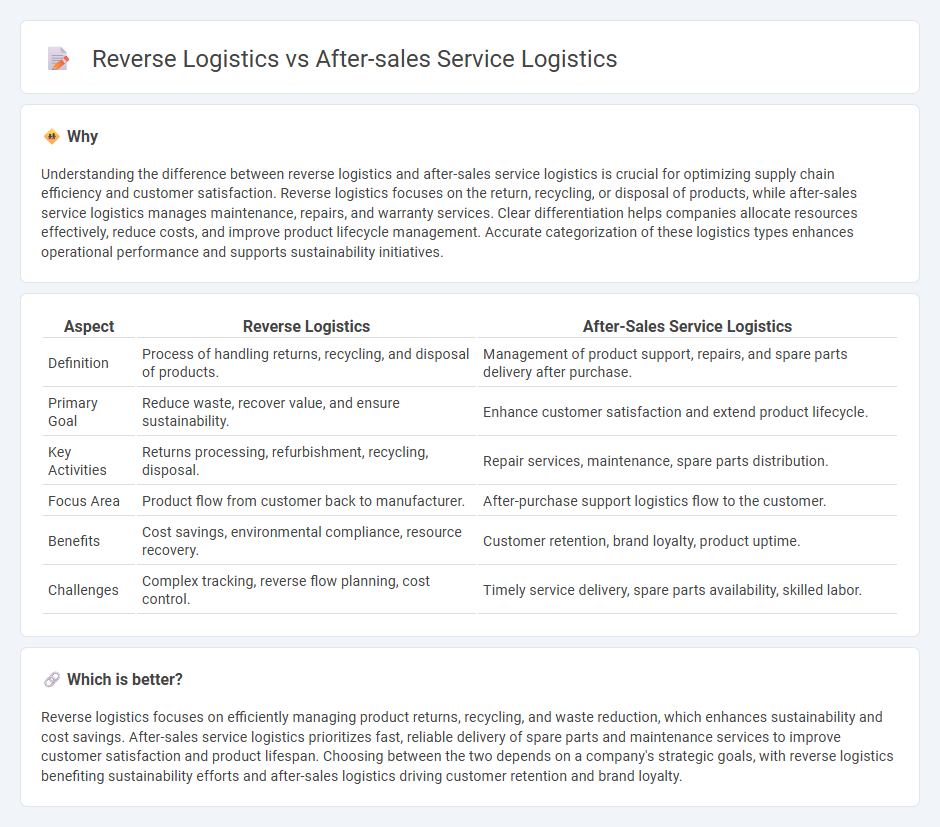
Reverse logistics focuses on the efficient return, recycling, and disposal of products from consumers back to manufacturers. After-sales service logistics ensures timely delivery of spare parts, repairs, and maintenance services to enhance customer satisfaction. Explore the key differences and benefits of each approach to optimize your supply chain management.
Why it is important
Understanding the difference between reverse logistics and after-sales service logistics is crucial for optimizing supply chain efficiency and customer satisfaction. Reverse logistics focuses on the return, recycling, or disposal of products, while after-sales service logistics manages maintenance, repairs, and warranty services. Clear differentiation helps companies allocate resources effectively, reduce costs, and improve product lifecycle management. Accurate categorization of these logistics types enhances operational performance and supports sustainability initiatives.
Comparison Table
| Aspect | Reverse Logistics | After-Sales Service Logistics |
|---|---|---|
| Definition | Process of handling returns, recycling, and disposal of products. | Management of product support, repairs, and spare parts delivery after purchase. |
| Primary Goal | Reduce waste, recover value, and ensure sustainability. | Enhance customer satisfaction and extend product lifecycle. |
| Key Activities | Returns processing, refurbishment, recycling, disposal. | Repair services, maintenance, spare parts distribution. |
| Focus Area | Product flow from customer back to manufacturer. | After-purchase support logistics flow to the customer. |
| Benefits | Cost savings, environmental compliance, resource recovery. | Customer retention, brand loyalty, product uptime. |
| Challenges | Complex tracking, reverse flow planning, cost control. | Timely service delivery, spare parts availability, skilled labor. |
Which is better?
Reverse logistics focuses on efficiently managing product returns, recycling, and waste reduction, which enhances sustainability and cost savings. After-sales service logistics prioritizes fast, reliable delivery of spare parts and maintenance services to improve customer satisfaction and product lifespan. Choosing between the two depends on a company's strategic goals, with reverse logistics benefiting sustainability efforts and after-sales logistics driving customer retention and brand loyalty.
Connection
Reverse logistics and after-sales service logistics are interconnected through the management of returned goods, repairs, and warranty claims to enhance customer satisfaction and operational efficiency. Efficient coordination between these logistics functions minimizes product lifecycle costs and supports sustainable practices by ensuring proper handling of returns and refurbishments. Integrating data from after-sales services enables better forecasting and process optimization in reverse logistics operations.
Key Terms
**After-sales service logistics:**
After-sales service logistics involves managing the distribution and transportation of spare parts, maintenance tools, and repair services to ensure customer satisfaction and product functionality post-purchase. This logistics streamlines warranty management, product returns for repair, and installation services, reducing downtime and enhancing brand loyalty. Discover how optimizing after-sales service logistics boosts operational efficiency and customer retention.
Spare Parts Management
Spare parts management in after-sales service logistics prioritizes efficient distribution, timely delivery, and inventory accuracy to ensure minimal downtime for customers. Reverse logistics handles the return, repair, refurbishment, or disposal of spare parts, aiming to optimize sustainability and cost recovery. Explore more insights on optimizing spare parts flow in both logistics domains.
Field Service Support
After-sales service logistics centers on field service support by ensuring timely repairs, maintenance, and parts availability at the customer's location to maximize operational uptime. Reverse logistics involves the process of managing returns, recycling, and disposal of products, often incorporating the retrieval of faulty equipment from the field. Explore how integrating efficient field service support enhances both after-sales logistics and reverse logistics outcomes.
Source and External Links
Exploring After-Sales Logistics and Service Excellence - CMTI - After-sales logistics involves the efficient delivery of finished products to customers, alongside essential services like customer onboarding, responsive support, training, warranty service, and hassle-free returns, all managed by an After-Sales Manager to ensure customer satisfaction and loyalty.
After sales logistics - Horvath - Horvath & Partners - After-sales logistics focuses on optimizing spare parts management, supplier reliability, and transparent communication to meet high customer expectations, with tailored solutions that improve supply chains and service profitability across industries.
After-sales service and its effects on logistics - Mecalux.com - After-sales service includes customer care and support after purchase, emphasizing 24/7 assistance, quick problem resolution, and comprehensive warehouse lifecycle management to sustain logistics performance and customer satisfaction.
 dowidth.com
dowidth.com